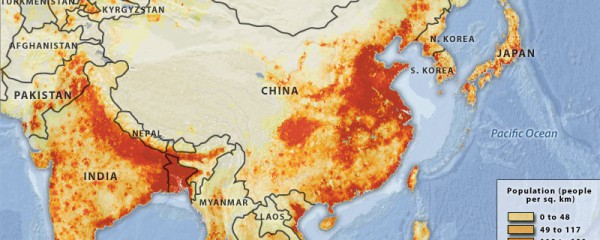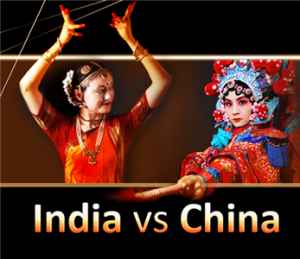02
Sep 2011
India v.s. China
It seems to be a national obsession in India: measuring the country’s economic development against China’s yardstick.
At a recent panel discussion to commemorate the 20th anniversary of India’s dismantling parts of its socialist economy, a government minister told business leaders to keep their eye on the big prize: growing faster than China.
“That’s not impossible,” said the minister, Palaniappan Chidambaram, who oversees national security and previously was finance minister. “People are beginning to talk about outpacing China.”
Indians, in fact, seem to talk endlessly about all things China, a neighbor with whom they have long had a prickly relationship, but which is also one of the few other economies that has had 8 percent or more annual growth in recent years.
Indian newspapers are filled with articles comparing the two countries. Indian executives refer to China as a template for development. Government officials cite Beijing, variously as a threat, partner or role model.
“Indians are obsessed with China, but the Chinese are paying too little attention to India,” said Minxin Pei, an economist who was born in China and who writes a monthly column for The Indian Express, a national daily newspaper.
Liu Yi, a clothing store owner in Beijing, echoed the sentiments of a dozen Chinese people interviewed in Beijing and Shanghai, in dismissing the idea that the two countries could be compared. Yes, he said India was a “world leader” in information technology but it also had many “backward, undeveloped places.”
“China’s economy is special,” Mr. Liu said. “If China’s development has a model, you could say it’s the U.S. or England.”
It might be only natural that the Chinese would look up the development ladder to the United States, now that it is the only nation in the world with a larger economy, rather than over their shoulders at India, which ranks ninth. And while China is India’s largest trading partner, the greatest portion of China’s exports go to the United States.
So for India, China represents the higher rung to strive for.
Like India, China traces its civilization back thousands of years and has a population of more than 1 billion people. And China has lessons to offer because, under Deng Xiaoping in the late 1970s and early ’80s, it started the transition to a more open and competitive economy more than a decade before India. Before Deng took power, India’s economy was bigger on a per-capita basis than China’s.
Whatever the reasons, Indians compare virtually every aspect of their nation with China. Infrastructure (China is acknowledged as being many kilometers ahead). The armed forces (China is more powerful). Universities (China has invested more in its institutions). The software industry (India is far ahead). Proficiency in the English language (India has the historical advantage, but China is catching up).
Evidence of the Indo-Sino interest disparity can be seen in the two countries’ leading newspapers. The People’s Daily, the Chinese Communist Party’s house organ, had only 24 articles mentioning India on its English-language Web site in the first seven months of this year, according to the Factiva database. By contrast, The Times of India, the country’s largest circulation English-language newspaper, had 57 articles mentioning China — in July alone.
There are other big gaps. Indian cities, large and small, are filled with Chinese restaurants that serve a distinctly ultraspicy, Indian version of that cuisine. But there are few Indian restaurants in Beijing or Shanghai, let alone in smaller Chinese cities.
In 2009, more than 160,000 Indian tourists visited mainland China, according to the Chinese government. Barely 100,000 Chinese tourists made the reverse trek, according to India’s government.
In early July, The Economic Times, India’s leading financial newspaper, ran a photo slide showon its Web site titled “How China builds these, and why India never does.” The slide show is a series of photographs of large infrastructure projects in China, including the a new 26-mile-long bridge linking Qingdao and the Huangdao district across the JiaozhouBay on the northeastern coast.
India’s views have also been shaped by a 1962 war that ended with China seizing a chunk of the northern India state of Kashmir. The countries still have an unsettled border, and China claims a large piece of territory controlled by India. […]
In China, however, India does not register as a threat, economically or otherwise.
Indian fascination with China’s economic success is also simplistic, Mr.Pei said. While one-party rule may have helped the country build infrastructure and factories in recent decades, it was also responsible for big failures under Mao Zedong. They include the Great Leap Forward and the Cultural Revolution, when millions of people starved or were killed or persecuted.
“Competition exists between any two nations,” said Hu Jun, a 40-year-old teacher in Shanghai. “That’s a good thing. If we compete in the areas of high-tech and energy saving, I think that will benefit everyone.”
In India, Shrayank Gupta, a 21-year-old student at the prestigious Indian Institute of Technology, Bombay, echoed those sentiments: “There will definitely be a race, because we are both naturally competitive, and the world will depend on both of us.”
Article extracted from The New York Times (http://www.nytimes.com)
– See more at: http://www.sbeintl.com/
































